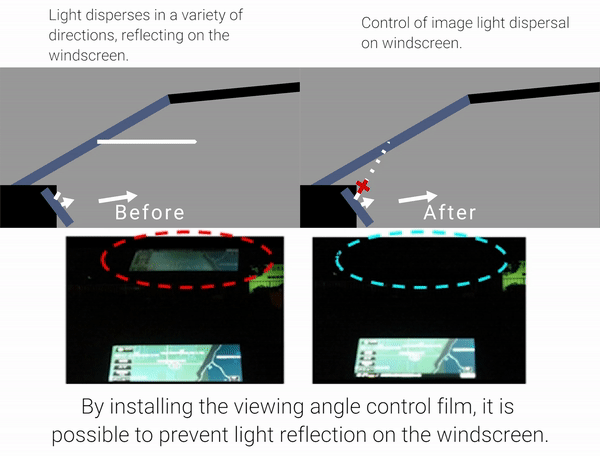What exactly is Snell’s law? And why is an electric car company interested in its dynamics? Snell’s law (also known as Snell–Descartes law and the law of refraction) is a formula used to describe the relationship between the angles of incidence and refraction, when referring to light or other waves passing through a boundary between two different isotropic media, such as water, glass, or air. The law is used in optical ray tracing to compute the angles of incidence or refraction and in experimental optics to find the refractive index of a material.
Faraday Future (FF), recently introduced the concept of the “Third Internet Living Space,” the conduit between one’s home and destination (office, school etc.) Part of this “space” is the benefit of connectivity, and part of it is the fact that FF 91 boasts as many as 11 screens throughout its interior.
We want to bring this Third Internet Living Space to our users and ensure that any potential issues of this space are eliminated. One of our passenger features that we are proud to introduce in the FF 91 is an industry-leading large 17” display upfront.
A lot of consideration was taken with putting this display into the car, including addressing challenges of the display being washed out in a bright environment or the display not being bright enough to be legible. One challenge we faced that is unique to the FF 91 design is preventing the display image from being reflected off the windshield.
As the display is placed further to the front of the car, the chance of its image being reflected off the windshield increases. Especially in a dark environment, this could be very distracting to the driver or passenger. Below, you can see how that image in the passenger viewing area is affected.
Most automobile manufactures avoid this challenge by using one of three solutions:
- Placing a hood-shaped object above the display. This can be evident in most car’s instrument cluster. Essentially, this blocks the light path of the display to the windshield. However, this limits the design, increases the weight, and limits the potential location of the display. In the image below, a hood is shown in front of the steering wheel and above the instrument cluster display.
- Placing the display farther “back” in the car. This technique is used mostly for center information displays. Displays placed farther back can reduce or eliminate the reflection path to the driver or passenger. Although this is an effective solution to reduce reflection, it is limited in practice, as the center display location can only be adjusted so much due to safety issues.
- Implementing a louver film that narrows the viewing cone of the display. Louver films have the basic structure of a privacy film. Even though this is a decent solution, Louver films also reduce the brightness of the display by about 30%. Compensating for this reduction in brightness requires more energy consumption and higher temperatures.
Below is a very simple image showing how the light path is theoretically removed using louver film.
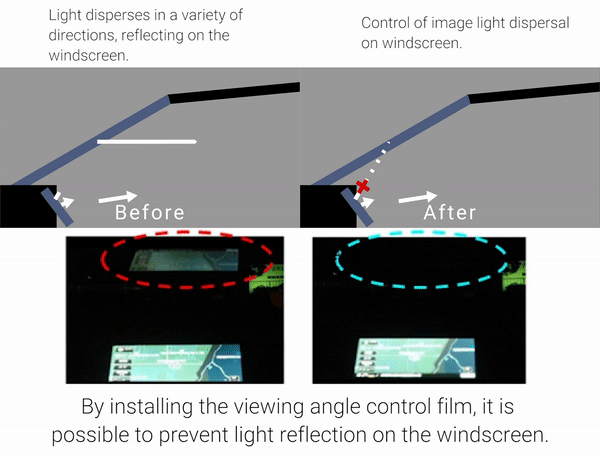
At Faraday Future, we faced a unique challenge in designing our Front Passenger Display to provide entertainment (video streaming, screen mirroring, and video conferencing), but while allowing the passenger airbag to function. As this is a unique feature to FF and FF 91, this led to FF finding a unique solution to a unique problem.
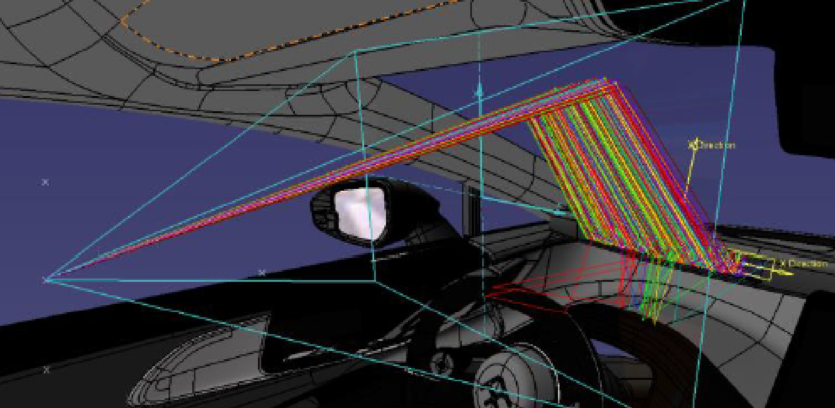
Because of our unique design, we faced unique challenges that could not be addressed using the conventional solutions above.
At FF, we look deeper into how to solve age-old automobile problems and try to come up with a solution based on analysis and creative thinking. When looking at this issue as illustrated below, we see that the position of the reflectance off the windshield is approximately 60 degrees. Below, you can see the path of the light that goes to the user’s eyes. Unpolarized light will reflect from the windshield twice, as the light as two interface boundaries that it will pass through. This means that, ordinarily, you would expect approximately eight percent of reflection of the passenger display off the windshield.
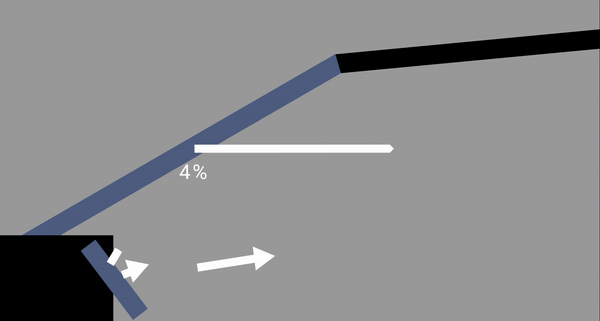
The percentage of the light being reflected is calculated using the Fresnel equations. This indicates the amount of reflection when light encounters a boundary (e.g., air and glass), but in this scenario, there are additional cons.
If we go further in the equations, we can see that the light being reflected from the windshield not only varies by angle, but also by the polarization of the light. By parsing out the light that is polarized in parallel vs light that is perpendicular to the plan of the boundary the graph below.
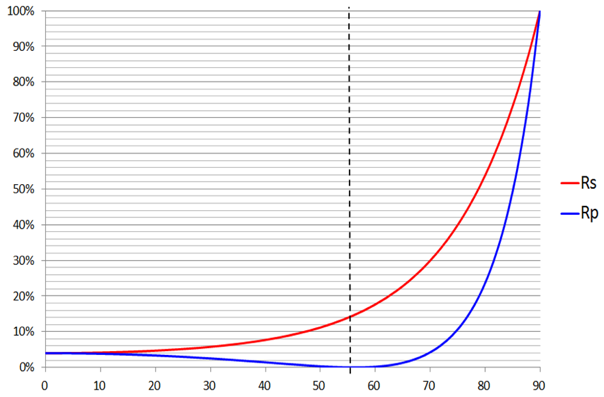
The graph indicates to us that the reflectance at 60 degrees of light that is polarized parallel to the barrier (windshield), will have near-zero reflectance. At FF, we knew that the output of displays is polarized. Therefore, we theorized that if we made sure that the light from the display was polarized in parallel (Rp) with the windshield, we might solve our problem with no need for any negative repercussions.
After further analysis, we made a quick experiment to verify our understanding. As shown below, we used a simple laptop (as most laptops are vertically polarized) to mimic our display and a piece of glass to mimic a windshield placed around 60 degrees between the observer and the display. Then we turned the laptop sideways and tried our experiment again (turning it sideways changes the polarized angle with respect to the reflected plane). As you can see below, at the right orientation, no reflection was visible from the display.
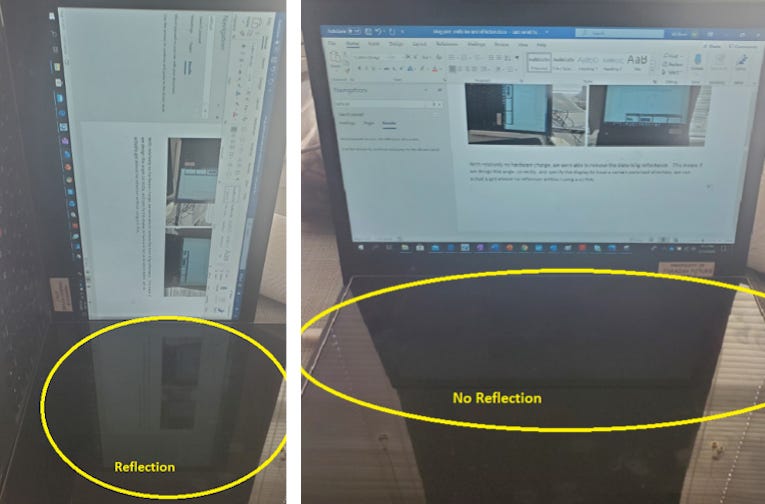
Thus, with relatively few hardware changes, we were able to remove the disturbing reflectance. This means that if we design the interface angle correctly and specify the display to have a certain polarized direction, we can achieve almost no reflection without using a louver film or a hood while still delivering on the design language.
At FF, there are no barriers that we are afraid to challenge, nor do we get held back by the status quo. From our analysis, we were able to determine a new solution that lowers cost, increases brightness, and reduces thermal issues. Everything about our cutting-edge vehicle and technology was created to make the lives of our users more connected, more engaging, and more effortless. Our goal at FF is to make your daily commute the highlight of your day through a rich digital experience and give you back more time in your day.
